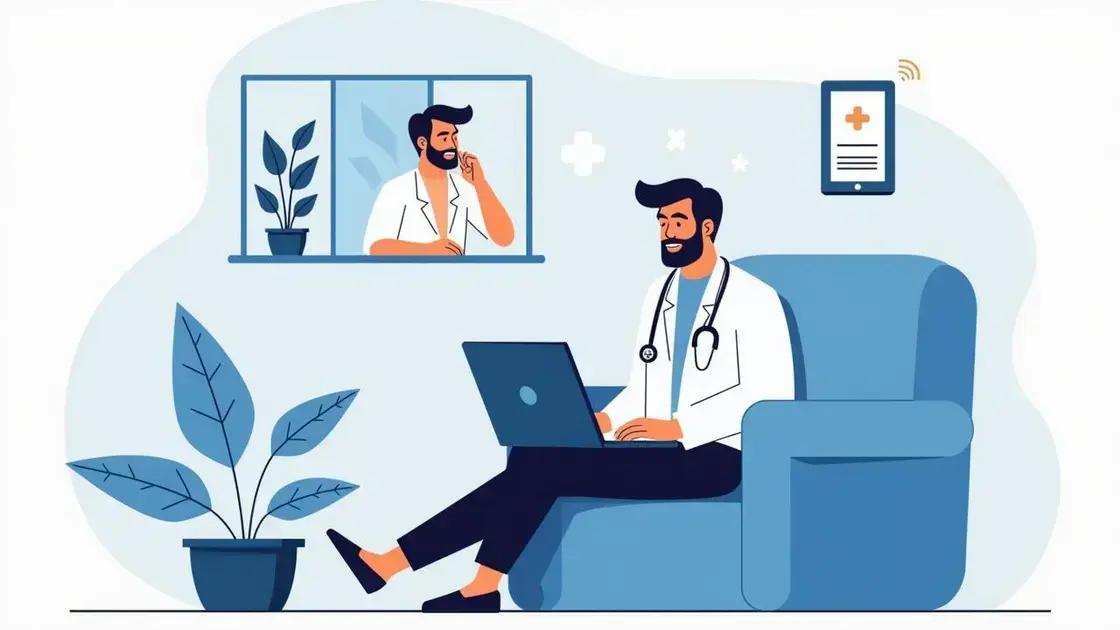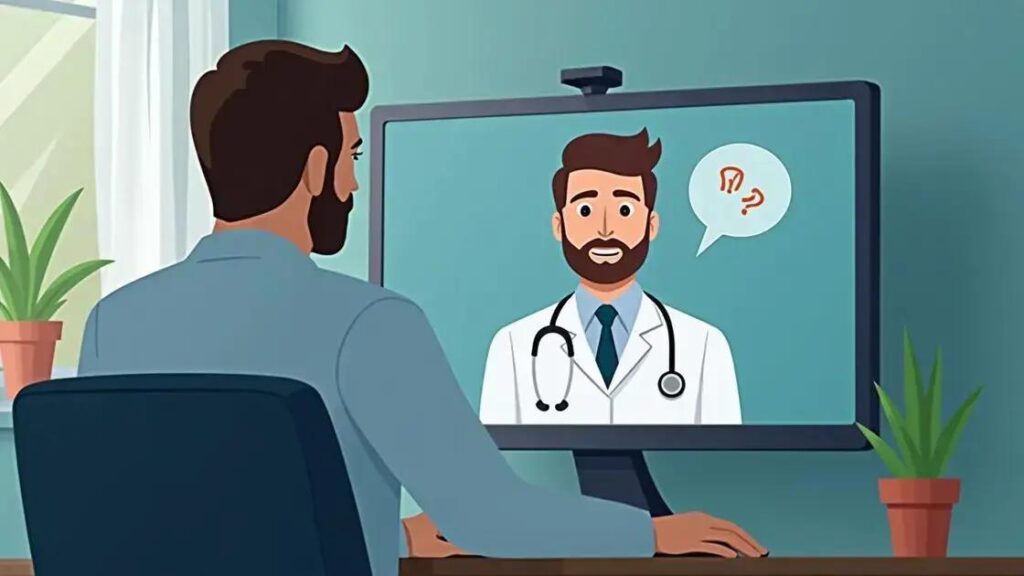Telemedicine is revolutionizing hormone therapy for men by making it more accessible through remote consultations, enhanced privacy, and timely care. Patients can conveniently receive diagnoses, treatment plans, and ongoing monitoring without the constraints of traditional office visits, all while benefiting from advancements like artificial intelligence and wearable health technology.
How telemedicine is making hormone therapy more accessible for men is transforming healthcare. By leveraging technology, men can now access vital treatments from the comfort of their homes. This innovative approach not only addresses privacy concerns but also improves access for those who may have trouble visiting a clinic. In this article, we will explore how hormone therapy works, the benefits of telemedicine, and the future trends that could further enhance men’s health.
Understanding hormone therapy and its benefits

Hormone therapy is a medical treatment that involves the use of hormones to address various health issues. For men, this can include the management of conditions such as low testosterone levels, which is essential for overall health and well-being. Understanding how hormone therapy works can help men make informed decisions about their health.
Benefits of Hormone Therapy
Hormone therapy offers a range of benefits, including:
- Improved Energy Levels: Many men report increased energy and improved mood after starting hormone therapy.
- Enhanced Libido: Hormone therapy can help boost sex drive, addressing issues many men face as they age.
- Muscle Mass and Strength: Therapy can help men maintain muscle mass and even promote growth, crucial for an active lifestyle.
- Better Mental Clarity: Hormone balance plays a role in mental acuity, and many patients notice improved cognitive functions.
Risks and Considerations
While hormone therapy can be beneficial, it also comes with potential risks. These can include:
- Heart Health: Men should discuss any existing heart conditions with their doctor.
- Sleep Apnea: Hormone therapy can aggravate this sleep disorder in some individuals.
- Changes in Mood: There may be fluctuations in mood that require monitoring.
It is essential for men to consult with healthcare professionals to understand these risks, ensuring the treatment aligns with their health goals.
Who Should Consider Hormone Therapy?
Men experiencing symptoms related to low testosterone levels should consider hormone therapy. Symptoms might include fatigue, depression, irritability, and decreases in sexual desire. A simple blood test can determine hormone levels, guiding the decision to pursue therapy.
In conclusion, hormone therapy can significantly enhance the quality of life for men facing hormonal deficiencies. Understanding its benefits and potential risks empowers men to take control of their health.
How telemedicine works in hormone therapy

Telemedicine has transformed how men receive hormone therapy. This approach uses technology to allow consultations with healthcare providers without the need for in-person visits. Here’s an overview of how telemedicine works in hormone therapy.
Initial Consultation
The process typically starts with an initial consultation. Men can schedule a virtual appointment with a healthcare provider, often through a secure video conferencing platform. During this appointment, patients discuss their symptoms, medical history, and any concerns they may have.
Testing and Diagnosis
After the initial consultation, the healthcare provider may recommend tests to check hormone levels. In many cases, patients can visit their local lab for blood testing. The results are then shared securely with the healthcare provider, who can assess whether hormone therapy is appropriate.
Personalized Treatment Plans
Once a diagnosis is made, the healthcare provider develops a personalized treatment plan. This plan can be adjusted based on the patient’s response to treatment over time. Men receive prescriptions electronically, ensuring they can easily access their medication from local pharmacies or have it delivered to their homes.
Ongoing Monitoring and Support
Telemedicine allows for continuous monitoring and support. Patients can schedule follow-up appointments to discuss progress and any side effects they may experience. This ongoing communication helps ensure that the therapy is effective and safe. Providers may also use online surveys or phone calls to check in with patients regularly, maintaining a strong support system.
In essence, telemedicine bridges gaps in access to healthcare for men seeking hormone therapy, making it more convenient and efficient to receive necessary treatment.
The accessibility of hormone therapy for men through telemedicine

Accessibility of hormone therapy for men has greatly improved with the rise of telemedicine. This transformation is crucial, especially for those who may face barriers such as time constraints, mobility issues, or geographical limitations.
Breaking Down Barriers
Many men live in areas where hormone therapy services are scarce. Telemedicine connects them with specialists without the need for long travels. Men can easily schedule consultations from their homes, making healthcare more attainable.
Privacy and Comfort
One of the greatest advantages of telemedicine is privacy. Many men feel uncomfortable discussing intimate health issues in person. Telemedicine provides a more comfortable environment for them to voice their concerns and seek help.
Efficient and Timely Care
Telemedicine enhances the speed of care. Men can receive timely consultations and follow-ups, ensuring they do not have to wait weeks for appointments. This efficiency is vital for managing hormone levels and overall health.
Cost-Effective Solutions
Accessing hormone therapy through telemedicine can also reduce costs. Patients save money on travel expenses and can potentially find more affordable treatment options online. Many insurance plans now cover telehealth consultations, making it an even more viable option.
In summary, telemedicine significantly increases the accessibility of hormone therapy for men, making it easier to receive essential healthcare services.
Future trends in telemedicine for men’s health

The future trends in telemedicine for men’s health are promising and rapidly evolving. As technology continues to advance, men can expect more efficient and accessible healthcare solutions.
Integration of Artificial Intelligence
One of the most significant trends is the use of artificial intelligence (AI) in telemedicine. AI can assist healthcare providers in diagnosing conditions more accurately and tailoring treatment plans. Chatbots and virtual assistants could help answer medical queries and schedule appointments, making the process smoother for patients.
Wearable Health Technology
Wearable technology is on the rise, allowing men to monitor their health in real-time. Devices can track hormone levels, heart rates, and other vital statistics. This data can be shared with healthcare providers during virtual consultations, leading to more informed decisions about treatment.
Increased Focus on Preventative Care
Telemedicine is shifting towards a focus on preventative care. Men can have regular check-ups and health assessments without the constraints of traditional appointments. This proactive approach helps identify issues early, promoting better long-term health outcomes.
Access to Specialized Care
The expansion of telemedicine allows for greater access to specialized care. Men can connect with experts in various fields, such as urology or endocrinology, regardless of their location. This ensures they receive the best possible advice and treatment tailored to their specific needs.
With these trends, telemedicine is set to enhance the way men approach their health, making it more convenient, comprehensive, and effective.
The Impact of Telemedicine on Men’s Hormone Therapy
Telemedicine is transforming the landscape of hormone therapy for men by making access to services more convenient and efficient. As we have explored, it breaks down geographical barriers, enhances privacy, and offers timely treatment options.
The integration of advanced technologies like AI and wearable health devices is an exciting trend that promises even greater improvements in men’s health management. With a focus on preventative care and access to specialists, men can proactively take charge of their health.
In summary, the future of telemedicine in men’s hormone therapy is bright, providing a path toward better health outcomes and empowering men to seek the care they need without the traditional obstacles that once existed.
FAQ – Frequently Asked Questions about Telemedicine and Hormone Therapy for Men
What is telemedicine?
Telemedicine is a way to provide healthcare services remotely using technology, such as video consultations and online health assessments.
How does telemedicine improve access to hormone therapy?
Telemedicine increases accessibility by allowing men to consult healthcare providers from home, regardless of their geographical location.
What are the benefits of hormone therapy for men?
Hormone therapy can improve energy levels, enhance libido, increase muscle mass, and provide better mental clarity.
Are there any risks associated with hormone therapy?
Yes, potential risks include heart health issues, sleep apnea, and changes in mood, so it’s essential to discuss these with your healthcare provider.
What future trends can we expect in telemedicine for men’s health?
Future trends include the integration of artificial intelligence, wearable health technology, a focus on preventative care, and increased access to specialized care.
Is telemedicine covered by health insurance?
Many health insurance plans now cover telemedicine services, but it’s important to check with your provider to understand your specific coverage.












